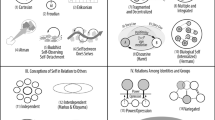Abstract
In the act of self-observation, an individual becomes simultaneously observer and observed, subject and object. While some philosophical psychologists have dismissed thisreflexivity, the present author proposes that it isthe essential feature of the self, making it the basis of a new, conceptually simple, structural and dynamic theory of the self. Drawing from psychopathology, poetry and literature, the author portrays normal and disordered psychological states as disturbances in reflexivity. Qualitative and quantitative variations in this core function are proposed to define discreet spectra of psychological situations. The author briefly examines the theories and practices of psychoanalytic and existential psychology, and proposes clinical applications of the new views here depicted. He attempts to show that inherent limits to our simultaneous knowledge of both aspects of the reflexive duality limit the precision and validity of all psychological theorization.
Similar content being viewed by others
References
Feynman RP. The development of the space-time view of quantum electrodynamics. In: Nobel Foundation.Les Prix Nobel en 1965. Stockholm: PA Nordstedt & Söner, 1966:172–91.
Heraclitus. Fragment 21. In: Wheelwright P, ed.The Presocratics. New York: Odyssey Press, 1966:71.
Hughes P, Brecht G.Vicious Circles and Infinity. Harmondsworth: Penguin, 1980.
Popper KR.Conjectures and Refutations: The Growth of Scientific Knowledge. New York: Harper and Row, 1968.
Grünbaum A.The Foundations of Psychoanalysis: A Philosophical Critique. Berkeley: University of California Press, 1986.
Havens L. The risks of knowing and not knowing.Journal of Social and Biological Structure 1982;5:213–22.
Webster's New International Dictionary of the English Language. 2nd ed, unabridged. Springfield, MA: Merriam, 1953.
Hamilton E, Cairns H, eds.Plato, The Collected Dialogues. Princeton: Bollingen, 1980.
Mead GH.Mind, Self and Society. Chicago: University of Chicago Press, 1934.
Ryle G.The Concept of Mind. Harmondsworth: Penguin University Books, 1973.
Mann D, Havens L. Depersonalization and the pathology of the self.Hillside J Clin Psychiatry 1987;9(2):144–51.
Wittgenstein L.Philosophical Investigations. NY: Macmillan, 1953.
Aristotle. Metaphysics. In: Barnes J, ed.The Complete Works of Aristotle. Vol 2. Princeton, NJ: Princeton University Press, 1984:1552–1728.
Gerard R. Units and concepts of biology.Science 1957;125:429–33.
Burns R. To a Louse. In: Cohen JM, Cohen MJ, eds.The Penguin Dictionary of Quotations. London: Penguin Books, Ltd, 1977:84.
Grant M, Hazel J.Gods and Mortals in Classical Mythology. NY: Dorset, 1985.
Vaillant G. A theoretical hierarchy of adaptive ego mechanisms.Arch Gen Psychiatry 1971;24:107–18.
Proust M.Remembrance of Things Past. NY: Vintage, 1982.
Rokeach M.The Three Christs of Ypsilanti. New York: Alfred Knopf, 1964.
Frazer J.The Golden Bough. NY: Macmillan, 1951.
Freud S.Interpretation of Dreams. London: Hogarth Press, 1961. (Strachey J, ed. The Standard Edition of the Complete Psychological Works of Sigmund Freud; Vol IV.)
Kvarnes R, Parloff G, eds.A Harry Stack Sullivan Case Seminar. NY: Norton, 1976.
Grotjahn M. Sigmund Freud and the Art of Letter Writing. In: Rittenbeek H, ed:Freud as We Knew Him. Detroit: Wayne State University Press, 1973:433–66.
Freud S.Introductory Lectures on Psychoanalysis. London: Hogarth Press, 1961. (Strachey J, ed. The Standard Edition of the Complete Psychological Works of Sigmund Freud; Vol. XV.)
Havens L.Approaches to the Mind. Boston: Little, Brown, 1973.
Havens L.Making Contact. Cambridge, MA: Harvard University Press, 1986.
Mann DW.Ownership: A Pathography of the Self (unpublished manuscript).
Jung CG.Psychological Types. 2nd ed. Princeton, NJ: Princeton University Press, 1971. (Read H, ed. The Collected Works of CG Jung; Vol VI.)
Havens L. A theoretical basis for the concepts of self and authentic self.J Am Psychoanal Assoc 1986;34(2):363–78.
Author information
Authors and Affiliations
Rights and permissions
About this article
Cite this article
Mann, D.W. Some philosophical directions towards a simple theory of the self. Theor Med Bioeth 12, 53–68 (1991). https://doi.org/10.1007/BF02134778
Issue Date:
DOI: https://doi.org/10.1007/BF02134778



